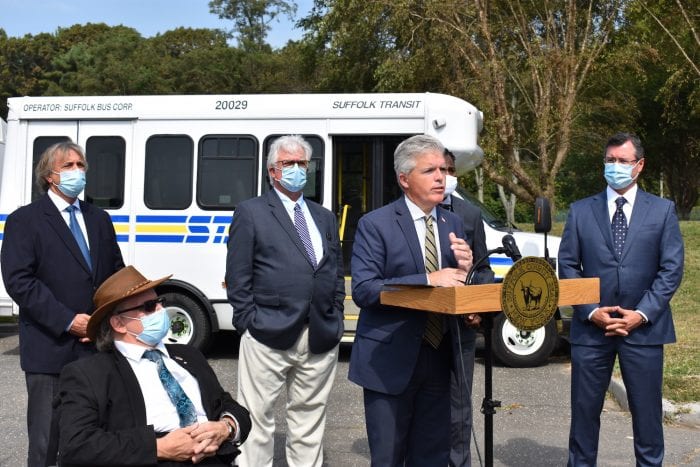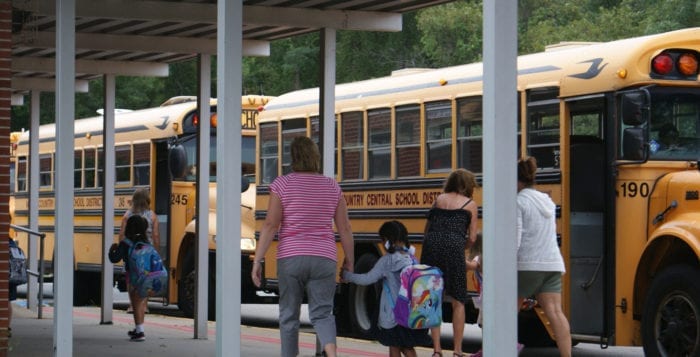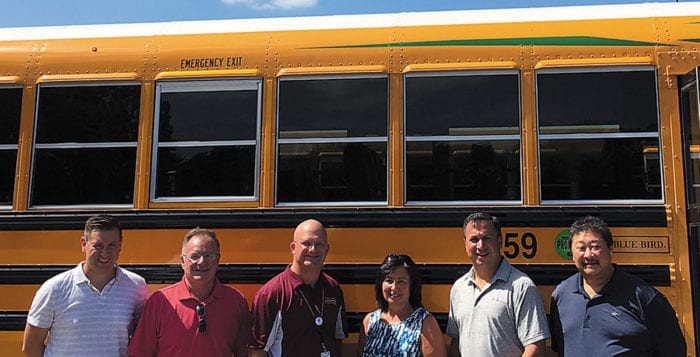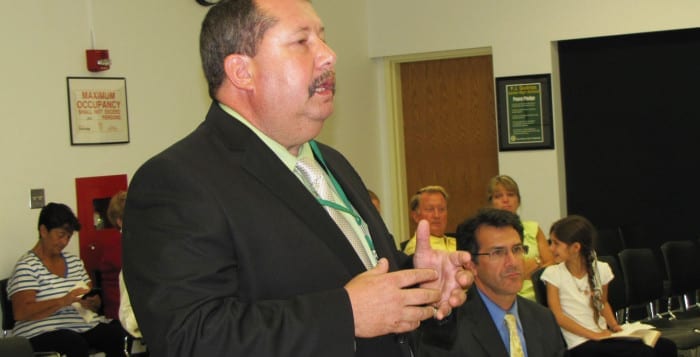County Executive Steve Bellone (D) has continued his calls for additional federal funds, now saying bus routes and bus drivers’ positions could be eliminated in the planned county budget to be released within the next week, officials said.
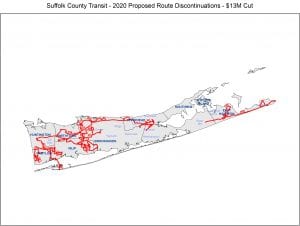
Bellone held a press conference Friday, Sept. 25, saying that cutting 19 bus routes and 25% of paratransit bus availability would result in about $18 million in savings for the county’s 2021 budget. The non paratransit routes, officials said, are equivalent to 2,500 riders a day, according to the pre-pandemic ridership levels. Cuts would impact about 200 daily riders who use the Suffolk County Accessible Transit service, and could also potentially eliminate hundreds of workers’ positions.
The routes themselves are spread out throughout the county, and though officials said those chosen would be busses with overall less ridership, they represent some of the only public transportation for certain areas. The S62, which runs across the North Shore from Riverhead to Hauppauge and is the only bus for places like Shoreham, Rocky Point and Miller Place, would be axed under current plans. The S54, which connects the Patchogue railroad to the Walt Whitman Mall is also in the crosshairs. Together, those routes contain the highest ridership and represent 887 daily riders, according to the county.
All Planned Route Cuts
- S54 – 548 riders per day
- 10B – 45 riders per day
- S59 – 90 riders per day
- S57 – 139 riders per day
- S31 – 12 riders per day
- S76 – 36 riders per day
- S56 – 89 riders per day
- 2A – 106 riders per day
- 7A – 60 riders per day
- 10C – 85 riders per day
- 6B – 108 riders per day
- S47 – 73 riders per day
- 8A – 131 riders per day
- S62 – 339 riders per day
- 1A – 63 riders per day
- 6A – 78 riders per day
- S69 – 3 riders per day
- 2B – 161 riders per day
- S23 – 149 riders per day
Other nixed routes include the S76, which connects Stony Brook and Port Jefferson Village and has an estimated 36 daily riders, may also get cut. The S56, which runs in Smithtown from Commack to Lake Grove with around 89 daily riders, could be eliminated as well.
This is all part of an anticipated 2021 county budget that Bellone said will include cuts across the board.
“Washington has failed to act,” Bellone said. “We need Washington to do its job, to do what it’s always done in times of crisis when local communities are hit by unprecedented natural disasters that are beyond the scope and capability of local government can handle.”
The cuts to personnel could be especially devastating, he said, considering many were “essential workers” who did their jobs even during the worst of the pandemic on Long Island. Many hospital and other frontline workers take the bus to work as well.
These planned cuts are despite receiving close to $26.6 million earlier this year in federal aid specifically for public transportation services. Bellone said the money has already been spent or allocated for the current year.
The total operating cost of Suffolk Transit is over $85 million, with more than $43 million being funded by the county, around $29 million from New York State, more than $4.4 million from the federal government, and $8.2 million in fares. Suffolk County estimates it will lose $6.1 million in farebox revenue in 2020, alongside a 20% or $6 million cut in state funding. Bellone’s office reported that the $26 million in federal funds allowed the county to operate the buses as normal during the height of the pandemic.
John Corrado, the president of Suffolk Transportation Services, a private company which operates all the buses used by Suffolk County, said they lost about 40% of ridership during the pandemic, and though numbers are coming back there is no way it can stave off the massive loss in farebox revenue.
In a repeat of last week’s press conference where Bellone announced major cuts to Suffolk County Police, Republicans in the county legislature held a retaliatory press conference of their own that same day. Legislator Rob Trotta (R-Fort Salonga), a member of the legislature’s Public Works, Transportation and Energy Committee, claimed the county is only down $4 million in bus fees. The GOP members of the legislature have constantly attacked Bellone on its financial situation, with officials often citing a 2019 report from the state comptroller calling Suffolk the most fiscally stressed municipality in the state.
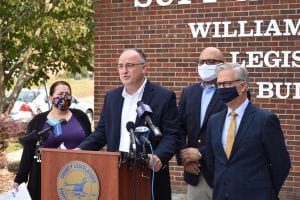
“To blame the federal government is a cop out,” Trotta said.
Though that aid that Suffolk received this year must be put towards current budget impacts due to the pandemic, Trotta said the numbers Bellone cited were off, and that the $26 million federal funds could be used now and all the savings could be rolled over into next year.
Though one will have to wait until the final 2021 budget is released before making any claims of what should or should not be cut, Republicans have claimed both this and other cuts to major services are unnecessary considering the CARES Act funding the county has already received to the tune of $257 million, not counting the additional public transit funds. This, they argued, should be enough to cover COVID-related expenses. Republicans said that new money is being used to pay for past financial mismanagement by the county executive.
Though when asked what else could be cut instead of these services, Republican legislators said they would need to see the full budget before making that determination.
Though some legislators admitted there is need for further federal aid, Legislator Anthony Piccirillo (R-Holtsville) suggested the federal government put a watchdog on the county executive to make sure the funds are spent correctly.
In response to the accusation the cuts are not needed, Bellone said since the county pays more than $40 million for the bus system, and though the federal funds have helped, they does not cover what will be a massive $800 million deficit for this year going into next year.
The planned cuts to public transportation would also impact the Suffolk County Accessible Transit buses, otherwise known as SCAT, which hundreds of residents with disabilities rely upon for service in doing things as simple as going to physical therapy or shopping for food. The service allows residents to schedule being picked up and dropped off, and represents one of the few tangible means for those lacking mobility and without personal transport for getting around.
Frank Krotschinsky, the director of the Office for People with Disabilities under the county executive, said “the county has gone above and beyond” in the offerings it has for disabled transport. He added the questions his office most commonly receives are from people asking about transportation.
“The day these cuts are made, people with disabilities will be disproportionately affected,” he said. “We need the federal government to step up to its role.”
The same day as the press conference, Bellone hosted a call with the county executives of Onondaga and Orange upstate counties, both of whom are Republican, in emphasizing the bipartisan need for additional relief from the federal government.
“As we put forward this budget, there is not going to be a part of this budget that involves discretionary spending that will not be impacted by Washington’s failure to act here,” Bellone said.

